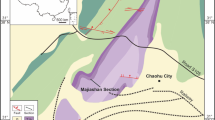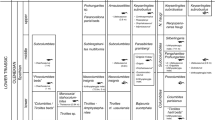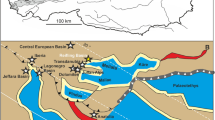Abstract
The fossil Kimberella quadrata was originally described from late Precambrian rocks of southern Australia1. Reconstructed as a jellyfish2, it was later assigned to the cubozoans (‘box jellies’), and has been cited as a clear instance of an extant animal lineage present before the Cambrian3,4,5,6,7. Until recently, Kimberella was known only from Australia, with the exception of some questionable north Indian specimens8. We now have over thirty-five specimens of this fossil from the Winter Coast of the White Sea in northern Russia. Our study of the new material does not support a cnidarian affinity. We reconstruct Kimberella as a bilaterally symmetrical, benthic animal with a non-mineralized, univalved shell, resembling a mollusc in many respects. This is important evidence for the existence of large triploblastic metazoans in the Precambrian and indicates that the origin of the higher groups of protostomes lies well back in the Precambrian.
This is a preview of subscription content, access via your institution
Access options
Subscribe to this journal
Receive 51 print issues and online access
$199.00 per year
only $3.90 per issue
Buy this article
- Purchase on Springer Link
- Instant access to full article PDF
Prices may be subject to local taxes which are calculated during checkout


Similar content being viewed by others
References
Glaessner, M. F. & Daily, B. The geology and Late Precambrian fauna of the Ediacara fossil reserve. Rec. S. Aust. Mus. 13, 369–401 (1959).
Glaessner, M. F. & Wade, M. The Late Precambrian fossils from Ediacara, South Australia. Palaeontology 9, 599–628 (1966).
Wade, M. Hydrozoa and Scyphozoa and other medusoids from the Precambrian Ediacara fauna, South Australia. Palaeontology 15, 197–225 (1972).
Glaessner, M. F. The Dawn of Animal Life(Cambridge University Press, Cambridge, (1984)).
Jenkins, R. J. F. Interpreting the oldest fossil cnidarians. Palaeontograph. Am. 54, 95–104 (1984).
Jenkins, R. J. F. in Origin and Early Evolution of the Metazoa(eds Lipps, J. H. & Signor, P. W.) 131–176 (Plenum, New York, (1992)).
Gehling, J. G. The case for Ediacaran fossil roots to the metazoan tree. Mem. Geol. Sco. India 20, 181–224 (1991).
Shanker, R. & Mathur, V. K. Precambrian–Cambrian sequence in Krol belt and additional Ediacaran fossils. Geophytology 22, 27–39 (1992).
Fedonkin, M. A. in The Vendian System Vol. 1(eds Sokolov, B. S. & Iwanowski, A. B.) 3–70 (Springer, Heidelberg, (1990)).
Fedonkin, M. A. Besskeletnaja fauna Venda i eë mesto v evoljutsii metazoa. Trudy Paleontologicheskogo Instituta 227, 1–174 (Nauka, Moscow, (1987)).
Grazhdankin, D. V. & Ivantsov, A. Yu. Reconstructions of biotopes of ancient Metazoa of the Late Vendian White Sea biota. Paleontol. J. 30, 674–678 (1996).
Wade, M. Preservation of soft-bodied animals in Precambrian sandstones at Ediacara, South Australia. Lethaia 1, 238–267 (1968).
McMenamin, M. A. S. & McMenamin, D. L. S. The Emergence of Animals: the Cambrian Breakthrough(Columbia University Press, New York, (1989)).
Smith, D. C. & Douglas, A. E. The Biology of Symbiosis(Arnold, London, (1987)).
Buss, L. W. & Seilacher, A. The Phylum Vendobionta: a sister group of the Eumetazoa? Paleobiology 20, 1–4 (1994).
Morton, J. E. in The Mollusca 11: Form and Function(eds Trueman, E. R. & Clarke, M. R.) 253–286 (Academic, San Diego, (1989)).
Conway Morris, S. & Peel, J. S. Articulated halkieriids from the Lower Cambrian of North Greenland. Nature 345, 802–805 (1990).
Conway Morris, S. & Peel, J. S. Articulated halkieriids from the Lower Cambrian of North Greenland and their role in early protostome evolution. Phil. Trans. R. Soc. Lond. B 347, 305–358 (1995).
Berrill, N. J. in The Tunicata: with an Account of the British Species. Figs 105, 106, 107(Ray Society, London, (1950)).
Seilacher, A. Vendobionta and Psammocorallia: lost constructions of Precambrian evolution. J. Geol. Soc. Lond. 149, 607–613 (1992).
Zhuravlev, A. Yu. Were Ediacaran Vendobionta multicellulars? N. Jb. Geol. Paläontol. 190, 299–314 (1993).
Retallack, G. J. Were the Ediacaran fossils lichens? Paleobiology 20, 523–544 (1994).
Valentine, J. W. Late Precambrian bilaterians: grades and clades. Proc. Natl Acad. Sci. USA 91, 6751–64757 (1994).
Acknowledgements
We thank the volunteers and colleagues who collected much of this material, inparticular A. Yu. Ivantsov, D. V. Grazhdankin, J. Woland and A. G. Collins; Yu. I. Nikolaev, L.S.Zakharchenkova, the Paleontological Institute in Moscow, and the Arkhangel'skgeologiya office inArkhangel'sk, for field logistical support; R. van Syoc (California Academy of Sciences) for access to specimens of extant invertebrates; D. R. Lindberg and J. G. Gehling for helpful comments; A. Mazin for photography and Y. A. Afanasiev for artwork.
Author information
Authors and Affiliations
Rights and permissions
About this article
Cite this article
Fedonkin, M., Waggoner, B. The Late Precambrian fossil Kimberella is a mollusc-like bilaterian organism. Nature 388, 868–871 (1997). https://doi.org/10.1038/42242
Received:
Accepted:
Issue Date:
DOI: https://doi.org/10.1038/42242
This article is cited by
-
Current understanding on the Cambrian Explosion: questions and answers
PalZ (2021)
-
New data from Monoplacophora and a carefully-curated dataset resolve molluscan relationships
Scientific Reports (2020)
-
Simple sediment rheology explains the Ediacara biota preservation
Nature Ecology & Evolution (2019)
-
Diverse Assemblage of Ediacaran fossils from Central Iran
Scientific Reports (2018)
-
The two phases of the Cambrian Explosion
Scientific Reports (2018)
Comments
By submitting a comment you agree to abide by our Terms and Community Guidelines. If you find something abusive or that does not comply with our terms or guidelines please flag it as inappropriate.



